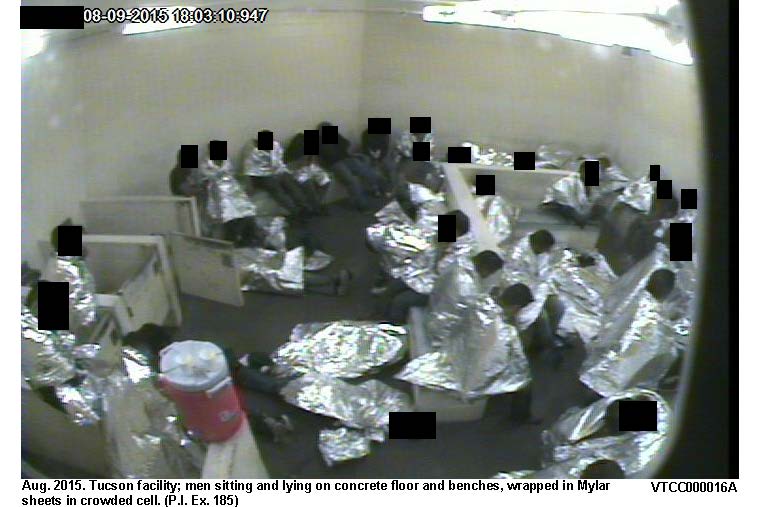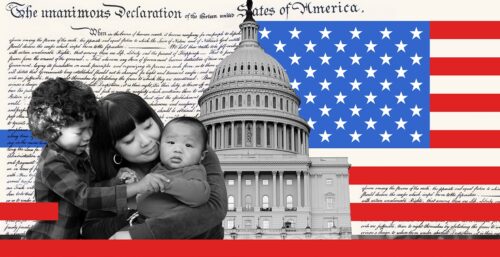Introduction
For some time now, U.S. Customs and Border Protection (CBP) has been in the spotlight for its questionable practices regarding the treatment of migrants. One such practice concerns the manner in which the Border Patrol—a component of CBP—operates its holding facilities near the U.S.’ southern border. Each year, hundreds of thousands of individuals are held in these facilities, which are meant to hold individuals for a short time while they undergo initial processing and until a decision is made about the appropriate next step in their case. The holding cells, which are often referred to as “hieleras” (Spanish for “freezers” or “iceboxes”), are typically small concrete rooms with concrete benches and no beds. They are not designed for overnight custody, and yet they are routinely used in this way. Government records analyzed in this report, which contain information on length of detention for all Border Patrol sectors along the U.S.’ southwest border, reveal that individuals are frequently held for days and sometimes even months in such facilities.
As numerous reports, media accounts, and documented complaints of former detainees have previously shown, these facilities remain wholly inadequate for any overnight detention. Moreover, the conditions are reprehensible—as consistently reported by many who were held in them—even with respect to truly short-term detention. In addition to the fact that there are no beds in the holding cells, these facilities are extremely cold, frequently overcrowded, and routinely lack adequate food, water, and medical care.
This report, which is based on never-before-released government data and documents obtained by the American Immigration Council through the Freedom of Information Act (FOIA), examines length of detention in nine Border Patrol sectors: Big Bend, Texas; Del Rio, Texas; El Centro, California; El Paso, Texas; Laredo, Texas; Rio Grande Valley, Texas; San Diego, California; Tucson, Arizona; and Yuma, Arizona. Between September 1, 2014 and August 31, 2015, 326,881 individuals were held in CBP facilities across the southwest border. Of the cases analyzed, which include only cases with complete data (326,728), 69,016 (21.1 percent) were women. Mexican nationals represent the largest share (57.1 percent) of those detained in CBP facilities during this period, followed by Guatemalans (16.9 percent), Salvadorans (12.7 percent), and Hondurans (9.8 percent).
Looking at all sectors combined, the data reveals that a shocking 217,485 individuals (or 67 percent of the total number detained during this period) were held in CBP facilities for 24 hours or more; 93,566 (29 percent) for 48 hours or more; and 44,202 (14 percent) for 72 hours or more. The average number of hours that individuals were detained shows some variation, ranging from 65 hours at its lowest point in July 2015 to 104 hours at its peak in October 2014.
Length of detention varies considerably across border sectors. For example, lengthy detention is remarkably frequent in the Laredo, Rio Grande Valley, Tucson, Yuma, and El Centro sectors. Laredo in particular shows the most disturbing numbers; 54 percent (19,000) of the 35,494 individuals held in detention facilities in Laredo were detained for at least 72 hours.
A recent report by the U.S. Government Accountability Office (GAO) raises questions about the possible existence of irregularities in the way Border Patrol officers capture information on length of detention. Consequently, the data presented here should be interpreted with caution. However, the findings of our analysis are consistent with those reported in previous publications by the American Immigration Council. For example, according to a report released in May 2015, 58,083 individuals—or over 80 percent of people detained by the Border Patrol in its Tucson Sector between January 1, 2013 and June 30, 2013—were held for over 24 hours, and 10.9 percent (7,839 individuals) were held for 72 hours or more. Another report which focused on the Rio Grande Valley Sector showed that during the months of August, September, October, and December of 2013, the share of individuals detained for over 72 hours ranged from 2.3 percent of all detainees at its lowest point to 42.5 percent at its peak.
Lengthy detention is especially problematic given the inhumane conditions that characterize these holding facilities. The findings presented in this report document a troublesome reality: lengthy detention is not just a random occurrence that happens to a few individuals in one or two Border Patrol sectors; it is, instead, a systemic practice that affects, to varying degrees, all the sectors along the southwest border.
Border Patrol and CBP Standards Governing Detention
Individuals are typically taken into CBP “short-term” holding facilities after being either (a) apprehended by the Border Patrol along the border and between ports of entry due to suspected criminal activity, illegal entry into the United States, or presence in the country without immigration status; or (b) interviewed by the Office of Field Operations at a port of entry to determine the individual’s admissibility into the United States. After inspecting an individual for admissibility or after making an apprehension, CBP may hold individuals at short-term holding facilities. According to GAO:
“[Department of Homeland Security (DHS)] components may hold aliens at holding facilities in order to complete general processing and determine the appropriate course of action, such as transferring them to or from a court, jail, prison, other agency or other unit of the facility or agency, relocating such aliens into ICE detention facilities, removing them from the country, or releasing them, among other scenarios.”
Although there are no statutes or regulations specifically governing CBP short-term detention facilities, CBP and Border Patrol have issued internal guidance regarding facility standards, specifications, and operations. According to CBP guidance, holding cells are generally rectangular, made of concrete, minimally furnished, and are neither designed nor equipped for overnight sleeping. Indeed, CBP policies specify that there are “no beds” in holding cells, as they are “not designed for sleeping.” As a Border Patrol spokesperson said, “it is what it is. We’re not a long-term hold facility.”
Agency guidance also sets limits on the maximum length of time that an individual should be kept in a holding cell. A 2008 Border Patrol memorandum states that “a detainee should not be held for more than 12 hours,” and should be moved “promptly.” It also recognizes that some individuals will be held for longer periods. This guidance was in effect for the time period of the government data analyzed for this report, and remains in effect at this time.
In addition to guidance on the length of detention, the 2008 memorandum proscribes that detainees will be provided snacks and meals, will be given access to potable drinking water, will have access to bathrooms and toilet items, and will be given necessary medical attention. Further, agents will make reasonable efforts to provide a shower for detainees held for more than 72 hours and detention cells will be regularly cleaned and sanitized.
In October 2015, CBP released the “National Standards on Transport, Escort, Detention, and Search” (TEDS) policy. The new standards define short-term detention as the “temporary detention of a person at a CBP facility for the least amount of time necessary to complete processing, transfer, and/or repatriation.” It also establishes that “detainees should generally not be held for longer than 72 hours in CBP hold rooms or holding facilities. Every effort must be made to hold detainees for the least amount of time required for their processing, transfer, release, or repatriation as appropriate and as operationally feasible.” The TEDS policy—which applies to all CBP components—does not replace the earlier 2008 memorandum that applies solely to Border Patrol facilities. As discussed below, the data demonstrates that Border Patrol was not previously—nor is it now—in compliance with its own guidance with respect to length of detention, as this detention regularly exceeded its own 12 hour limit as well as the 72 hour limit found in TEDS. This is particularly problematic considering that, as previous reports have shown, the agency is also not in compliance with other aspects of the guidance that relate to detention conditions.
Overview of Detention Patterns in All Border Patrol Sectors in the Southwest Border Region
The Southwest border region comprises nine Border Patrol sectors (Figure 1). Collectively, these sectors cover more than 2,000 miles of international border with Mexico and now include 74 stations and substations. In Fiscal Year (FY) 2015, the Border Patrol apprehended 331,333 individuals along the U.S.-Mexico border. Of those individuals, 147,257 (44 percent) were apprehended in the Rio Grande Valley sector; 63,397 (19 percent) in the Tucson sector; 35,888 (11 percent) in the Laredo sector; 26,290 (eight percent) in the San Diego sector; 19,013 (six percent) in the Del Rio sector; 14,495 (four percent) in the El Paso sector; 12,820 (four percent) in the El Centro sector; 7,142 (two percent) in the Yuma sector; and 5,031 (two percent) in the Big Bend sector.
Figure 1: Map of Border Patrol Sectors Along the Southwest Border
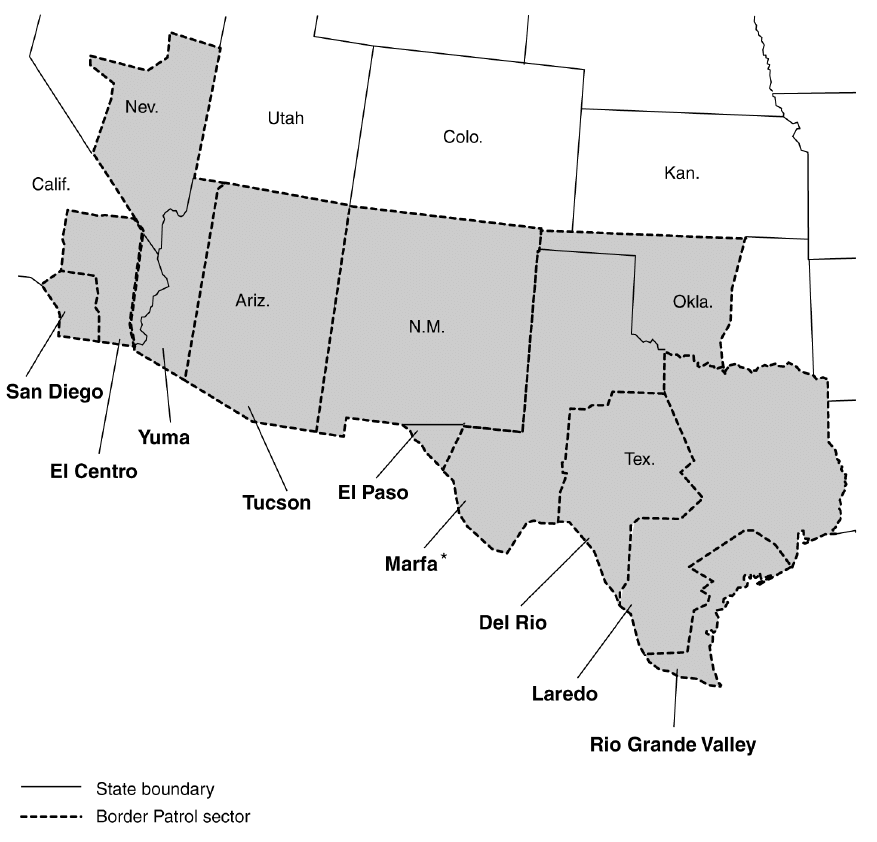
Source: U.S. Government Accountability Office, “Secure Border Initiative Fence Construction Costs,” GAO-09-244R, January 29, 2009, http://www.gao.gov/new.items/d09244r.pdf.
*Note: The Big Bend Sector was formerly known as Marfa Sector.
Between September 1, 2014 and August 31, 2015, 326,728 individuals were held in CBP facilities across the southwest border. Of them, 69,016 (21.1 percent) are women. Mexican nationals represent the largest share (57.1 percent) of those detained in CBP facilities during this period, followed by Guatemalans (16.9 percent), Salvadorans (12.7 percent), and Hondurans (9.8 percent).
A shocking 217,485 individuals (or 67 percent of the total number detained during this period) were held in CBP facilities for 24 hours or longer; 93,566 (29 percent) for 48 hours or more; and 44,202 (14 percent) for 72 hours or more (Figure 2).
Figure 2: Distribution of Individuals Detained in CBP Facilities by Length of Detention
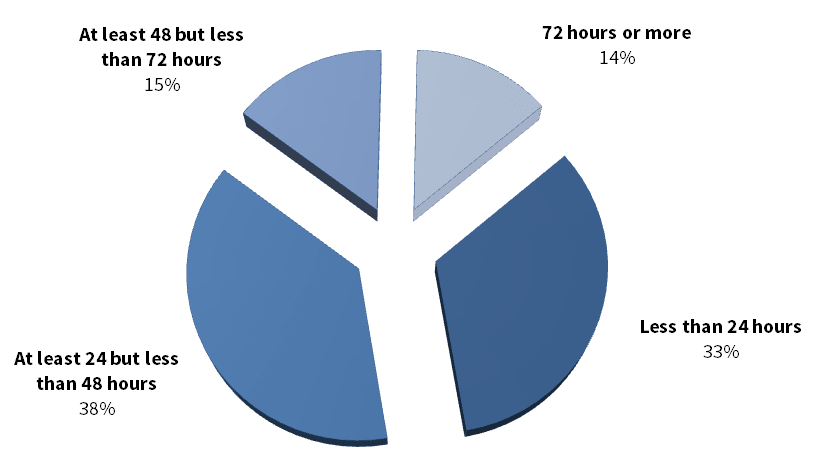
Source: Data generated by the American Immigration Council based on U.S. Border Patrol Southwest Border Apprehensions data obtained through Freedom of Information Act.
During the period analyzed, the average number of hours that individuals were detained showed some variation, ranging from 65 hours at its lowest point in July 2015 to 104 hours at its peak in October 2014 (Figure 3).
Figure 3: Average Number of Hours in CBP Detention, by Month
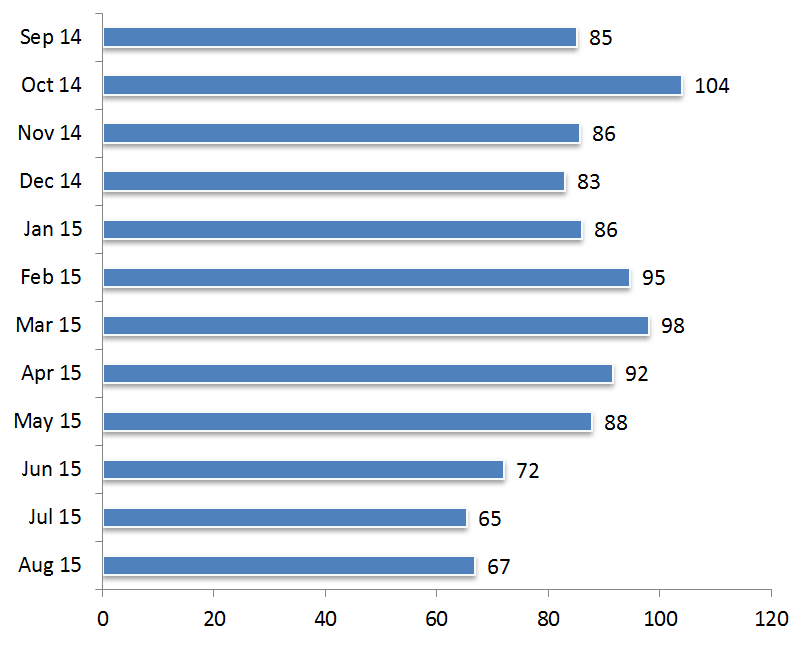
Source: Data generated by the American Immigration Council based on U.S. Border Patrol Southwest Border Apprehensions data obtained through Freedom of Information Act.
Length of detention varies considerably across border sectors (Figure 4). Notably, over 80 percent of the individuals detained between September 1, 2014 and August 31, 2015 in Laredo (29,585) and Rio Grande Valley (117,847), and over half of the individuals held in Yuma (3,664), Tucson (33,776), and El Centro (5,958), respectively, were held for 24 hours or more. Laredo has the largest share of individuals detained for 72 hours or more during this period. Specifically, 54 percent (19,000) of the 35,494 individuals held in detention facilities in Laredo were detained for at least 72 hours (Figure 5).
Figure 4: Individuals Held in CBP Facilities by Southwest Border Sector and Length of Detention
Sep. 1, 2014 – Aug. 31, 2015
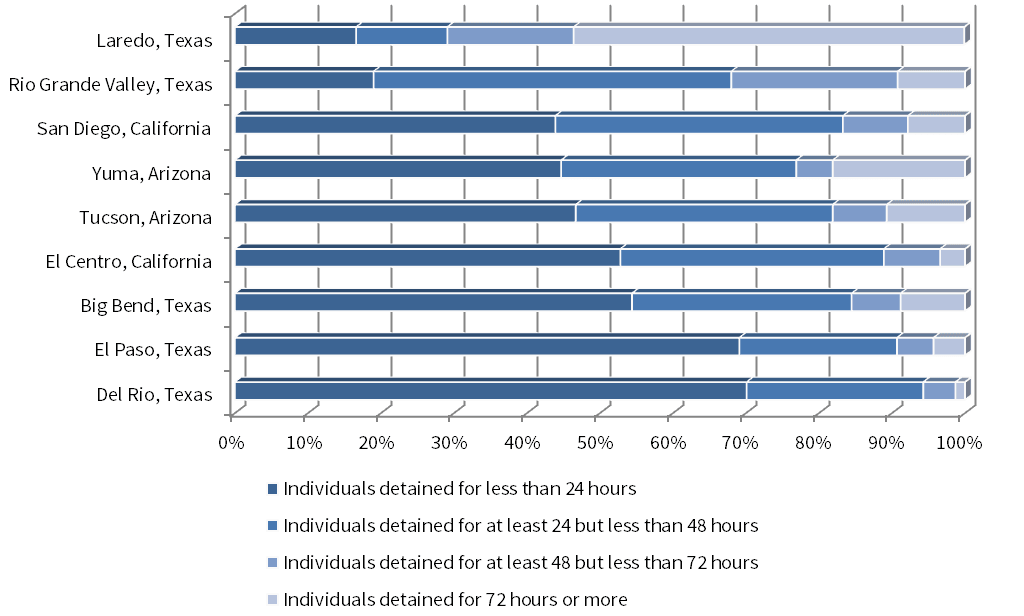
Source: Data generated by the American Immigration Council based on U.S. Border Patrol Southwest Border Apprehensions data obtained through Freedom of Information Act.
Figure 5: Individuals Held in CBP Facilities by Southwest Border Sector and Length of Detention
Sep. 1, 2014 – Aug. 31, 2015
|
Sector |
Less than 24 hours |
At least 24 but less than 48 hours |
At least 48 but less than 72 hours |
72 hours or more |
Total |
|---|---|---|---|---|---|
|
Laredo, Texas |
5,909 (17%) |
4,437 (13%) |
6,148 (17%) |
19,000 (54%) |
35,494 (100%) |
|
Rio Grande Valley, Texas |
27,602 (19%) |
71,287 (49%) |
33,098 (23%) |
13,462 (9%) |
145,449 (100%) |
|
San Diego, California |
11,592 (44%) |
10,411 (39%) |
2,351 (9%) |
2,057 (8%) |
26,411 |
|
Yuma, Arizona |
2,965 (45%) |
2,132 (32%) |
329 (5%) |
1,203 (18%) |
6,629 (100%) |
|
Tucson, Arizona |
29,564 (47%) |
22,290 (35%) |
4,668 (7%) |
6,818 (11%) |
63,340 (100%) |
|
El Centro, California |
6,654 (53%) |
4,553 (36%) |
976 (8%) |
429 (3%) |
12,612 (100%) |
|
Big Bend, Texas |
2,430 (54%) |
1,346 (30%) |
299 (7%) |
393 (9%) |
4,468 (100%) |
|
El Paso, Texas |
9,700 (69%) |
3,030 (22%) |
697 (5%) |
607 (4%) |
14,034 (100%) |
|
Del Rio, Texas |
12,827 (70%) |
4,433 (24%) |
798 (4%) |
233 (1%) |
18,291 (100%) |
|
Total |
109,243 (33%) |
123,919 (38%) |
49,364 (15%) |
44,202 (14%) |
326,728 (100%) |
Note: Percentages may not sum to 100 due to rounding.
Source: Data generated by the American Immigration Council based on U.S. Border Patrol Southwest Border Apprehensions data obtained through Freedom of Information Act.
The average amount of time that individuals were detained was over 24 hours across all sectors (Figure 6). The sectors where individuals were detained on average for the longest periods were Laredo, Texas (166.6 hours); Yuma, Arizona (150.4 hours); and Tucson, Arizona (128.4 hours).
Figure 6: Average Number of Hours Individuals Were Held in Detention, by Sector
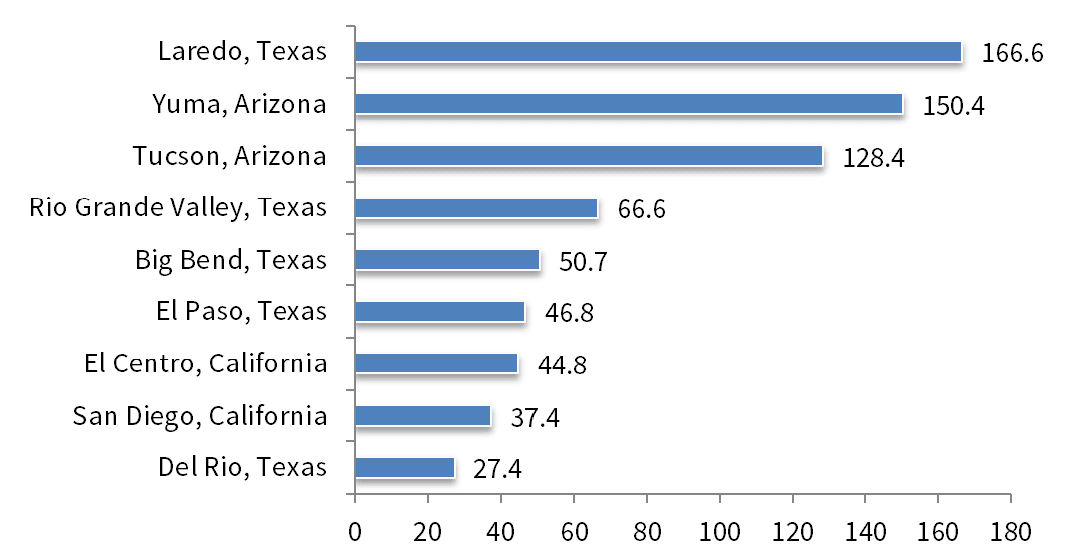
Source: Data generated by the American Immigration Council based on U.S. Border Patrol Southwest Border Apprehensions data obtained through Freedom of Information Act.
Because the mean is sensitive to outliers and, as we discuss below, there are extreme values in our dataset (which indicate that individuals were held for months), the median is probably a more accurate measure. Still, in six of the nine sectors analyzed, the median number of hours individuals were detained was higher than 24 (Figure 7). The sector with the greatest median was Laredo, Texas (77 hours), followed by Rio Grande Valley, Texas (39 hours) and Del Rio, Texas (27.4 hours).
Figure 7: Median Number of Hours Individuals Were Held in Detention, by Sector
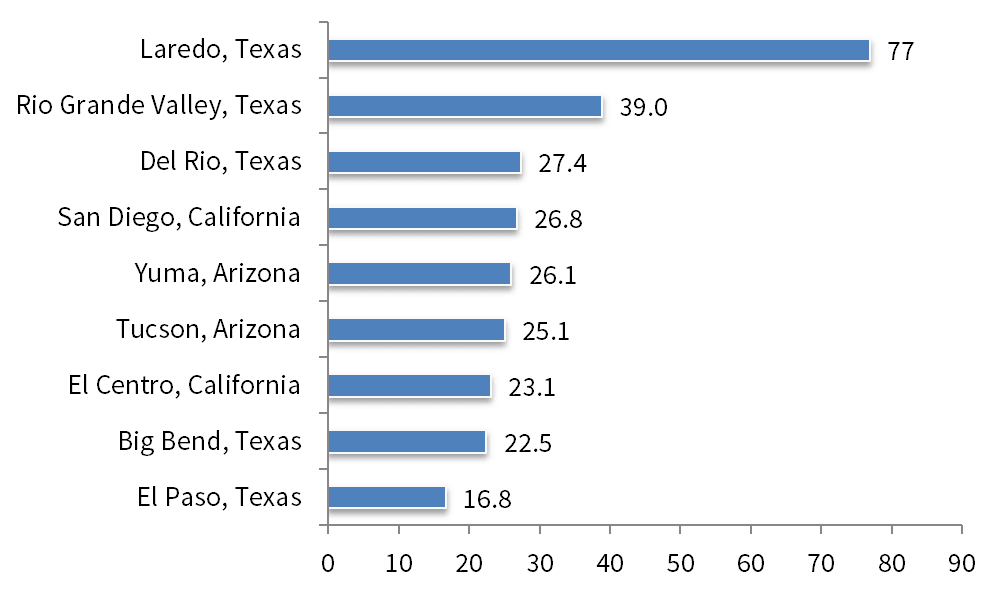
Source: Data generated by the American Immigration Council based on U.S. Border Patrol Southwest Border Apprehensions data obtained through Freedom of Information Act.
Alarmingly, the data also indicate that each sector had someone detained in one of its facilities for at least seven months. It also shows that someone in Laredo was detained for 13 months, 13 days (Figure 8). DHS officials we interviewed for this report also noted that some individuals are referred for prosecution for “illegal entry” or “reentry” under 8 USC §§ 1325 and 1326 and subsequently serve jail time. These individuals may not be “booked out” of CBP custody until they are returned to CBP and repatriated after serving their sentences, making their time in CBP custody appear longer than it actually was.
Figure 8: Maximum Number of Hours Someone Was Detained in Each Sector
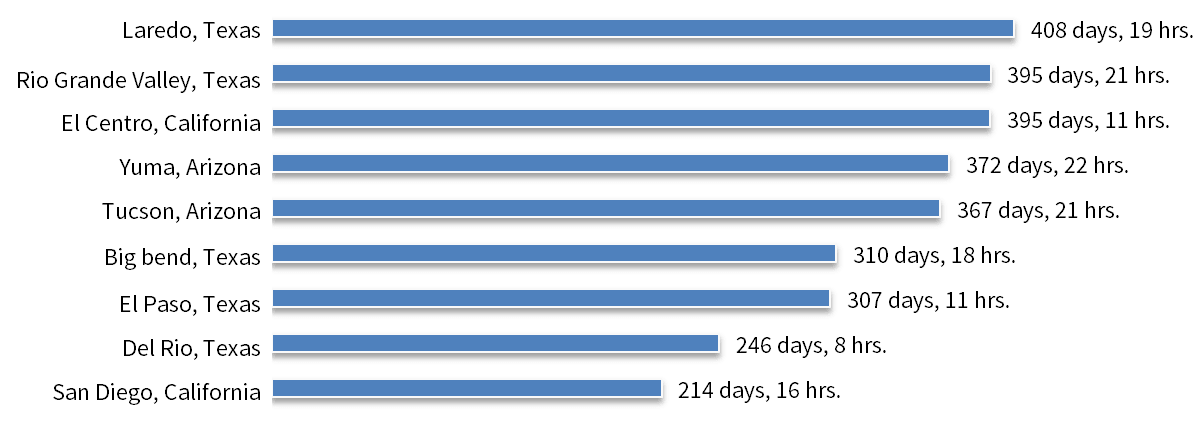
Source: Data generated by the American Immigration Council based on U.S. Border Patrol Southwest Border Apprehensions data obtained through Freedom of Information Act.
During the period analyzed, it appears that 6,814 individuals were held in CBP “short-term detention” facilities for at least a month. Of these, the largest share (3,214) was detained in Tucson; 1,577 in Rio Grande Valley; 1,226 in Laredo; 384 in Yuma; and the remaining 366 in the other sectors. In addition, the data suggest that 3,123 individuals were held for at least two months. Of those individuals, Tucson held the largest number (1,314); followed by Rio Grande Valley (876); Laredo (552); Yuma (202); El Paso (80); and El Centro (47).
These numbers are indeed worrisome. Although CBP released the data in response to our FOIA without a caveat, there may be a question as to the accuracy of some of it. A report by GAO found some irregularities with CBP time of custody data, due in part to “delays in agents recording of individuals’ book out from holding facilities.”
Conclusion
This newly released data shows that CBP—through its component Border Patrol—routinely forces individuals to sleep in cells that lack beds or other reasonable sleeping accommodations, often for multiple nights, in all southwest border sectors. And while lengthy detention is a frequent occurrence in all sectors, the numbers are especially alarming in many sectors—namely Laredo, Rio Grande Valley, Tucson, Yuma, and El Centro. In all of these sectors, more than 50 percent of the detainees were held for 24 hours or more. Laredo, in particular, presents the most alarming outcomes, with 54 percent of individuals held in its detention facilities for at least 72 hours. Such detention is far in excess of the 12-hour limit proscribed by Border Patrol, and is particularly troubling considering the deplorable detention conditions that previously have been reported.
